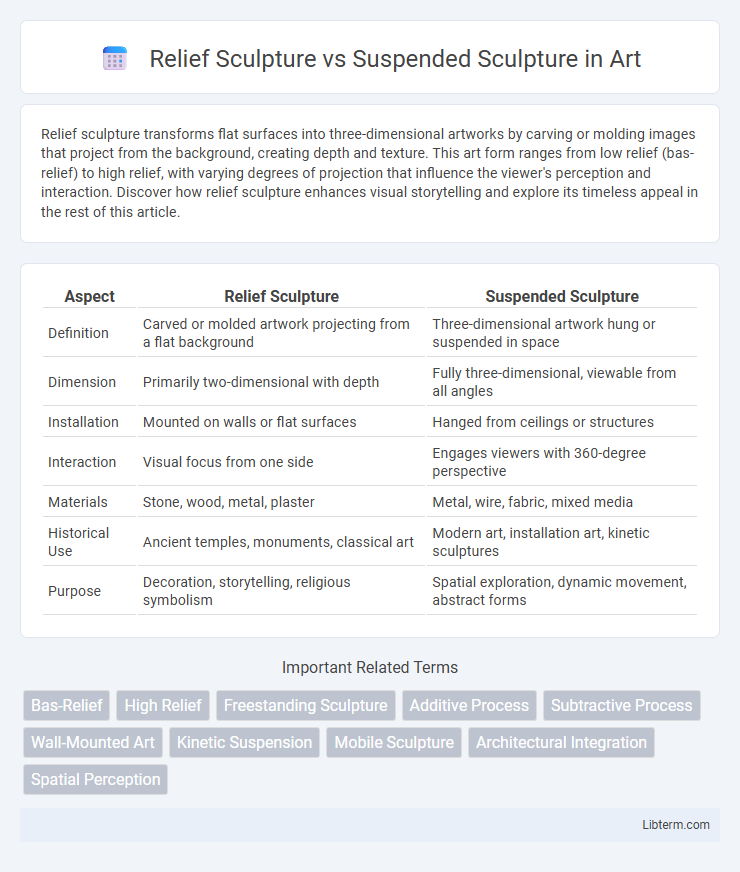Relief sculpture transforms flat surfaces into three-dimensional artworks by carving or molding images that project from the background, creating depth and texture. This art form ranges from low relief (bas-relief) to high relief, with varying degrees of projection that influence the viewer's perception and interaction. Discover how relief sculpture enhances visual storytelling and explore its timeless appeal in the rest of this article.
Table of Comparison
| Aspect | Relief Sculpture | Suspended Sculpture |
|---|---|---|
| Definition | Carved or molded artwork projecting from a flat background | Three-dimensional artwork hung or suspended in space |
| Dimension | Primarily two-dimensional with depth | Fully three-dimensional, viewable from all angles |
| Installation | Mounted on walls or flat surfaces | Hanged from ceilings or structures |
| Interaction | Visual focus from one side | Engages viewers with 360-degree perspective |
| Materials | Stone, wood, metal, plaster | Metal, wire, fabric, mixed media |
| Historical Use | Ancient temples, monuments, classical art | Modern art, installation art, kinetic sculptures |
| Purpose | Decoration, storytelling, religious symbolism | Spatial exploration, dynamic movement, abstract forms |
Introduction to Relief and Suspended Sculpture
Relief sculpture is a technique where the sculpted elements remain attached to a solid background of the same material, creating a raised or recessed image that interacts with light and shadow. Suspended sculpture, also known as hanging sculpture, features elements that are freely hanging or balanced in space, often creating dynamic movement and changing perspectives. Both forms emphasize dimensionality but differ in their spatial interaction and structural support.
Defining Relief Sculpture: Key Characteristics
Relief sculpture is characterized by its partial projection from a flat background, creating a raised image that maintains a strong connection to the surface plane. Unlike suspended sculptures, which are fully three-dimensional and freestanding, relief sculptures emphasize depth variation through techniques such as bas-relief and alto-relief. Key features include contour carving, varying degrees of relief to suggest shadow and texture, and often a narrative or decorative function integrated into architectural elements.
Understanding Suspended Sculpture: Essential Features
Suspended sculpture is characterized by its three-dimensional form hanging freely in space, often anchored by wires or cables, allowing it to be viewed from multiple angles. Unlike relief sculpture, which is attached to a solid background and relies on depth variation to create imagery, suspended sculptures emphasize spatial interaction and movement. Key features include balance, tension, and the dynamic relationship between the artwork and its surrounding environment, making it a versatile medium for capturing fluidity and lightness.
Historical Origins and Evolution
Relief sculpture dates back to ancient Mesopotamia and Egypt, where artists carved images into stone walls to depict religious and historical narratives, evolving through classical Greek and Roman periods into Renaissance bas-reliefs. Suspended sculpture, emerging prominently in the 20th century with artists like Alexander Calder, introduced kinetic elements and three-dimensional forms hanging freely in space, transforming sculptural art into dynamic experiences. The evolution of relief sculpture centers on its integration with architectural surfaces, while suspended sculpture emphasizes spatial interaction and movement.
Techniques Used in Relief vs Suspended Sculpture
Relief sculpture involves carving or modeling figures that project from a flat background, using techniques such as bas-relief, where the projection is slight, or high relief, where forms are more pronounced, often applied in stone, wood, or metal panels. Suspended sculpture relies on balancing, welding, or assembling materials like metal, glass, or mixed media to create three-dimensional forms that hang or float, emphasizing spatial interaction and gravity defiance. While relief emphasizes depth on a plane, suspended sculpture techniques prioritize structural integrity and dynamic movement within open space.
Material Choices: Comparing Both Forms
Relief sculpture typically uses materials like stone, wood, or metal that can be firmly attached to a background surface, enabling detailed carving or engraving. Suspended sculpture often utilizes lightweight materials such as aluminum, fiberglass, or mixed media to allow for balance and movement while hanging freely in space. Material selection directly impacts the structural integrity and aesthetic dynamics, with relief sculptures favoring durability and permanence, and suspended sculptures emphasizing lightness and spatial interaction.
Spatial Interaction and Viewer Experience
Relief sculpture, integrated into a flat surface, offers a tactile depth that engages viewers through limited spatial interaction, often emphasizing the narrative within a confined plane. Suspended sculpture occupies three-dimensional space freely, creating dynamic viewer experiences by allowing movement around and under the form, enhancing spatial awareness and sensory engagement. The contrast between the anchored intimacy of relief art and the immersive freedom of suspended pieces defines distinct modes of interaction and perception in sculptural art.
Notable Artists and Iconic Examples
Relief sculpture, characterized by its partial projection from a flat background, is exemplified by artists like Donatello, whose "Saint George" relief demonstrates intricate depth and detail. Suspended sculpture, which often occupies three-dimensional space without a solid base, includes works by Alexander Calder, renowned for pioneering kinetic mobiles such as "Lobster Trap and Fish Tail." These iconic examples highlight the distinct approaches of relief, anchored to surfaces, versus the spatial freedom of suspended sculptures.
Aesthetic and Functional Considerations
Relief sculpture integrates into architectural surfaces, enhancing visual depth and storytelling while maintaining structural stability, making it ideal for historical and narrative contexts. Suspended sculpture occupies three-dimensional space freely, offering dynamic interaction with viewers and environment, often emphasizing form, motion, and light effects. Functional considerations include relief's suitability for exterior facades or confined spaces versus suspended sculpture's need for strong support systems and spatial clearance.
Choosing Between Relief and Suspended Sculpture
Choosing between relief sculpture and suspended sculpture depends on spatial context and viewer interaction; relief sculptures integrate seamlessly with walls or flat surfaces, creating depth through carved or modeled imagery that enhances architectural settings. Suspended sculptures offer dynamic three-dimensional forms that engage viewers from multiple angles, suitable for open spaces where light and movement emphasize artistic impact. Consider relief for narrative storytelling and structural harmony, while suspended sculptures excel at creating visual intrigue and spatial presence.
Relief Sculpture Infographic

 libterm.com
libterm.com